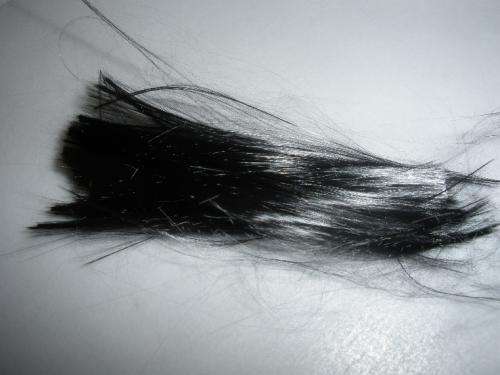Strengthening carbon fiber for vehicle use

Lighter-weight, fuel-efficient cars may be closer to reality thanks to Geelong researchers who are giving carbon fibre the gripping power it needs to be able to stand up to impacts from motorists.
High-performance vehicles already use carbon fibre – a high-strength lightweight material that can be moulded into complex shapes – to make cars lighter, more fuel-efficient and faster.
But although strong, carbon fibre is prone to damage from sudden impact. And unlike metal, it can't be repaired – only replaced.
This factor has limited the material's uptake by the wider automotive industry, as the common bingle would end up costing motorists a lot more to fix.
Ms Linden Servinis, a PhD student at Deakin University, and her colleagues have developed a treatment for carbon fibre that makes it 16% stronger by forming extra chemical 'arms' that grip onto its surroundings, allowing the material to withstand greater impacts.
"The carbon fibre composite materials we work with are made of black hair-like carbon fibres weaved together and coated in hard plastic," explains Linden – a FameLab Australia national finalist.
"They're extremely light-weight and stronger than steel, but in the event of impact damage, like in a car crash, the individual fibres break free of the plastic and the strength is lost.
"But we've found a way to help the fibres hold together – we've given them extra chemical arms to grab on to eachother and hold on to their plastic casing."

Linden and her colleagues discovered that large sections of the carbon fibre surface, which were previously thought to be useless, are actually an untapped resource for chemical reactions where extra 'arms' can be grown.
By creating a less damage-prone material, Linden hopes to increase the likelihood of wider carbon fibre uptake by the automotive industry.
"If we can get more carbon fibre into cars, they'll be lighter and more-fuel efficient, which is going to be really important in developing the cars of the future," says Linden.
Their research also shines light on further possibilities for altering a range of carbon fibre surfaces.
Increasingly used in aerospace, high-performance automotive, sporting, and oil and gas industries, carbon fibre materials are replacing traditional materials such as steel and aluminium.
Growing carbon fibre arms in the lab
Carbon fibre composites are the future of light weight and fuel efficient vehicles, but they aren't quite perfect yet. Made up of weaved black strands of fibre surrounded with a plastic reinforcement, they are stronger than steel and have very low weight. However, in the event of impact damage, there is often irreversible damage done, as the individual fibres slide free of the plastic, and all of the strength of the material which is provided by the fibres is lost. This is called debonding failure. So how can debonding be minimised or even prevented?
Drawing inspiration from the chemistry performed using carbon nanotubes – a much more perfect, and much smaller version of a carbon fibre – Linden selected three different chemical strategies. Each strategy used the parts of the carbon fibre surface that haven't been used before, and added new chemical 'arms' which could allow the fibre to hold onto the surrounding plastic.
The three different strategies were applied to pristine carbon fibres using organic chemical reactions.
According to spectroscopic analysis all three chemical 'recipes' had worked. Some better than others, but they had all introduced new chemical arms on a part of the fibre previously considered redundant.
The next question was, will the new chemical arms grab onto it surrounding plastic and prevent debonding?
Taking some of the enhanced fibres from the three recipes, Linden surrounded each of them with the reinforcement material. Then she broke them.
Using a microscope to look at the broken fibers, coupled with some clever maths and statistics, Linden confirmed that her reactions had worked. The new chemical arms formed from the three reactions had clung on to the surrounding plastic reinforcement, reducing the amount of debonding which occurred. These discoveries are the first step on the road to the perfect carbon fibre composite, and the light weight, fuel efficient vehicles of the future.
More information: Servinis L, et al. "Surface functionalization of unsized carbon fiber using nitrenes derived from organic azides." Carbon, 2013, 54, 378-388 www.sciencedirect.com/science/ … ii/S0008622312009426
Journal information: Carbon
Provided by Science in Public





















